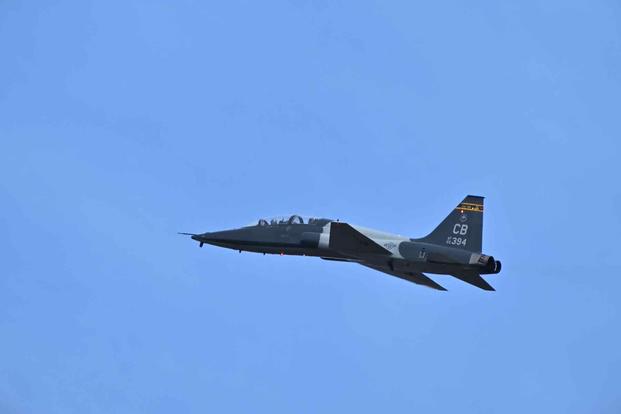
A T-38 Talon crash in November in Mississippi that caused a pilot to eject from the training jet was caused by a bird shattering the cockpit canopy, Air Force investigators detailed in an accident report.
The instructor pilot from Columbus Air Force Base in Mississippi, who was not named in the report, had to eject and landed in nearby trees, where he had non-life-threatening injuries. The aircraft was valued at $8.5 million and was “completely destroyed,” according to the report, which was released this month.
“The bird hit the cockpit canopy, shattering it upon impact,” the report detailed. “Pieces of the shattered canopy were ingested into both engines. The left engine immediately failed, and shortly after stopped spinning or working altogether.”
Read Next: House Republicans Vote to Block VA from Changing Motto to Include Female Veterans
Two T-38Cs took off Nov. 7, each with one person, an instructor, aboard. They were flying in a formation when one of the jets experienced the malfunction. The pilot was “highly experienced and capable,” Col. Jeremy Bergin, then the Columbus Air Force Base vice wing commander, said at the time, and praised the airman for his quick thinking during the incident.
Investigators found the pilot “could not avoid the bird,” according to the report. The pilots followed the proper mitigation techniques, and “the greatest risk for the training identified was a possible bird strike.”
Bird strikes are not an uncommon occurrence, but are rarely fatal. Air Force Safety Center data shows that between fiscal years 2000 and 2020, the latest information available, there were 11 destroyed aircraft and four fatalities as a result of bird strikes.
The Air Force has been flying the T-38 since the 1960s. The two-seat, supersonic jet trainer is still used by the service, as well as by the Navy and NASA, to instruct pilots.
Since 1960, there have been 211 Class A mishaps, the term used by the military to describe the deadliest or costliest crashes, according to Air Force Safety Center data. There have been a total of 86 pilot deaths and 149 fatalities in the T-38’s 63-year history.
The Air Force has been planning for several years to phase out the T-38 Talon.
In September 2018, the service gave Boeing Co. a $9.2 billion contract to build a replacement aircraft, with a working name of T-X. In 2019, the Air Force rebranded the T-X as the T-7A Red Hawk, named in honor of the Tuskegee Airmen.
While the first T-7A was originally expected to be delivered sometime in 2023, software issues and concerns connected to the ejection system have pushed the first deliveries into 2025. A full fleet now won’t be available to airmen until 2027.
— Thomas Novelly can be reached at [email protected]. Follow him on Twitter @TomNovelly.
Related: Air Force Faces 2-Year Delay on New T-7 Training Jets as Old Aircraft Continue to Have Mishaps






